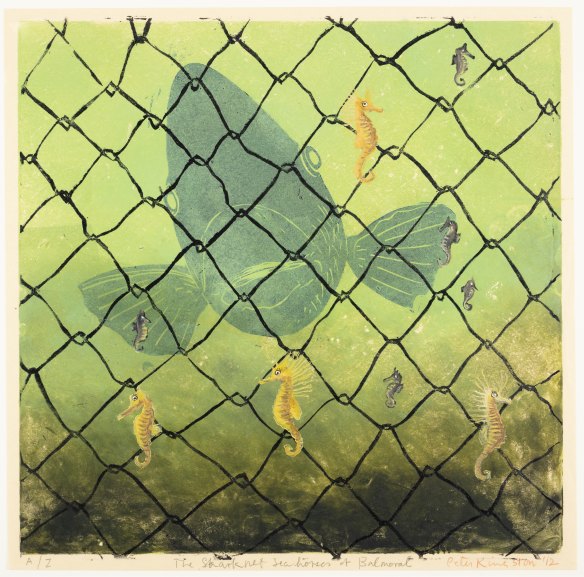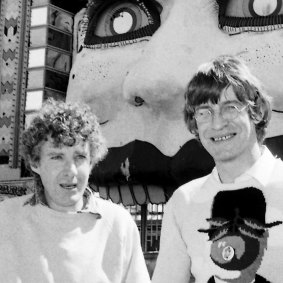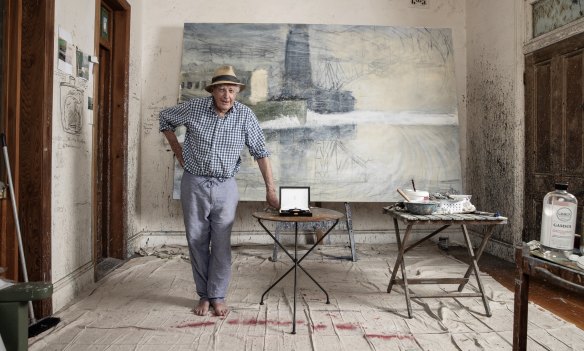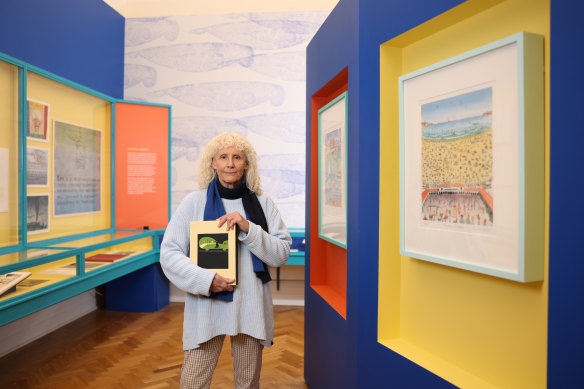
“At St Vincent’s Hospital, where he had his treatment, he drew everyone who drew blood from him,” says Fairlie, a ceramicist, who became an artist thanks to her brother’s lead. “We really clicked on a trip we took together when I was 16, and we always remained incredibly close, and that endured until his final breath.”
Now in an exhibition at the State Library, which is a sort of love letter to the artist, 70 works including prints, artist’s books, sketchbooks and printing plates from across Kingston’s career are on display until May 18.

Shark-net seahorses of Balmoral: a harbour memoir by Peter Kingston.Credit: Annie Tong
Cork met Kingston at the Newcastle Hotel in George Street, the now-demolished pub that was once a literary and arts hub due to its proximity to The Bulletin and Angus & Robertson offices. It was not long after he’d finished high school at Cranbrook, where he’d met his friend and fellow artist Martin Sharp. Cork was a secretary for sculptor Clement Meadmore, and then became a printmaker and worked with Kingston, at the time a uni student, on some of his early works.
“Somehow, we encountered Brett Whiteley, and we’d go on little excursions into the country with him, and Peter eventually moved next to him in Lavender Bay after living in squalor in Surry Hills,” Cork says.

Peter Kingston with Martin Sharp in 1973.Credit: Martin Brannan
Fairlie recalls Kingston as a devoted big brother who could draw for as long as she can remember.
“For my sixth birthday he made a puppet theatre for me … He loved cartoons – our father worked for 20th Century Fox, and used to bring these clippings home off the cutting room floor. Peter would splice together Mighty Mouse and Heckle and Jeckle and show them on the projector in this little projection room under the house. He managed to nearly electrocute himself once. So that was how he fell in love with cartoons.”
The exhibition includes an oral history in which Kingston talks frankly about his agoraphobia, which crippled him for some years. Before his death, he did two days’ worth of interviews with the State Library, with which he had worked for 40 years, explains Elise Edmonds, one of the exhibition curators.
“Luna Park was a childhood special place and I had a long conversation with him during lockdown about his love of it as a kid, then as an adult working at the park,” says Edmonds, who along with co-curator Mathilde de Hauteclocque, will give a talk on the artist on June 25.

Peter Kingston at his home in Lavender Bay in 2021.Credit:
Kingston not only repainted most of the artwork currently in Coney Island, but he also had a collection of Luna Park memorabilia he’d bought at auction. In the days after his death, the State Library photographed these and other mementoes, including his last work in his studio. Some of these photos feature in the exhibition.

Peter Kingston’s sister Fairlie Kingston at The State Library of NSW exhibition.Credit: Dylan Coker
“The harbour was No.1,” says Fairlie. “He was busy saving everything else on the harbour except his house, which was colder than Mawson’s hut, so he would always go to bed early.”
Fairlie hopes the exhibition gives a glimpse of his acerbic wit and sense of fun.
“He would go to the cabaret nights at the Yellow House dressed up as a magician in an old cape that was a bedspread, and he would have Arkie Whiteley aged seven or eight as his magician’s assistant,” she says.
Loading
“We were all in awe of his energy,” says Cork, recalling how Kingston would drive most mornings from Lavender Bay to Coogee to swim at Wylie’s Baths because he loved its old-world feel.
“Once they changed the front of Wylie’s Baths, painting out its original facade,” Fairlie says. “So he announced ‘we’re taking a ladder today’ and he painted the stripes back in at the entrance just as it had always been since it opened. It was going to be a plain old facade, but now the stripes are iconic – a memory of old art deco Sydney, thanks to Peter.
“He was like a terrier – Peter made things happen.”



























